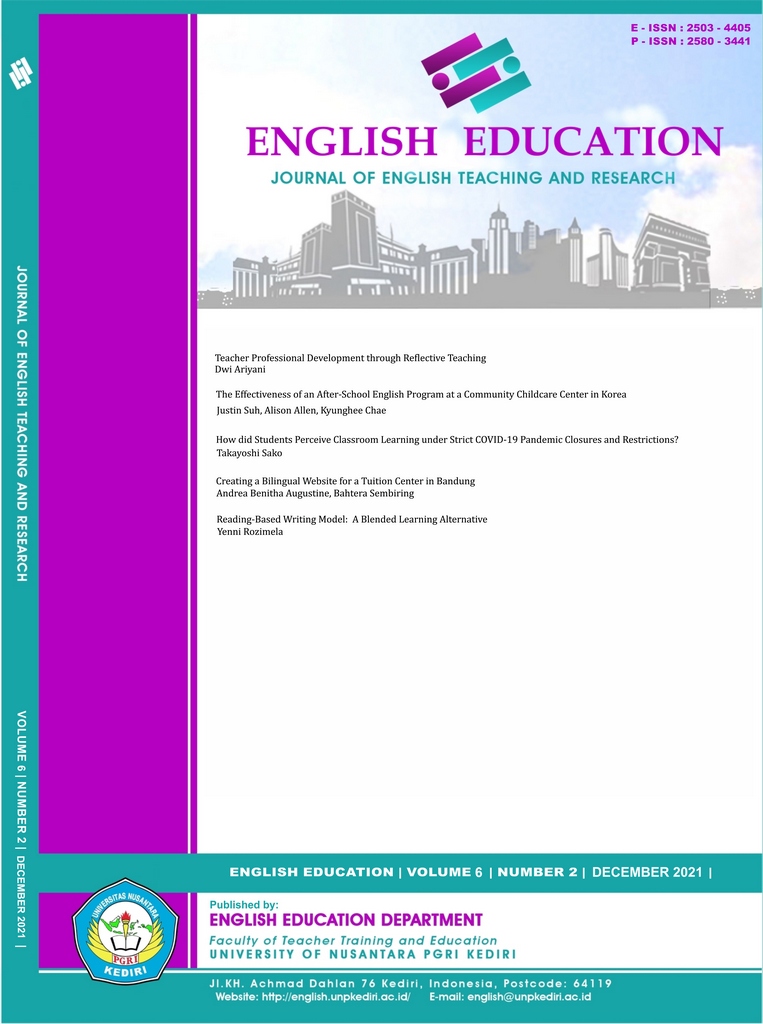Creating a Bilingual Website for Bimbingan Belajar Smart Club
DOI:
https://doi.org/10.29407/jetar.v6i2.16959Keywords:
website, bilingual website, tuition centerAbstract
Following the widespread use of the Internet, more businesses are available online to attract more customers and unleash the limits of offline businesses. Not only e-commerces, but websites can be owned by businesses which provide services as what they sell. The reason behind this is that many have found the importance of websites. An example of service businesses is tuition center. This website project is about creating a bilingual website for a tuition center in Bandung. Qualitative methodology was used in collecting the data, and the methods were observation, interview, and library study. This project is aimed to give detailed information, to promote, and to persuade visitors to join the tuition center.
Downloads
References
Assistant Secretary for Public Affairs. (2016). Writing for the web.
Blanc, M. H. A., & Hamers, J. F. (2002). Bilinguality and bilingualism (2nd ed.). International Journal of Bilingualism, 6(2), 221–223. https://books.google.com/books/about/Bilinguality_and_Bilingualism.html?hl=id&id=ata9lBT5euwC
Computer Hope. (2020). What is a website? https://www.computerhope.com/jargon/w/website.htm
Creswell, J. (1994). Research design: Qualitative & quantitative approaches. 228.
Gorman, G. E., Clayton, P., Shep, S. J., & Clayton, A. (2005). Qualitative research for the information professional: A practical handbook. 282.
Kirdkoh, S., & Ngamrung, S. (2019). A study of bilingual websites as a marketing communication tool in tourism industry: The case study of cafés in Phitsanulok, Thailand. 10th National and International Conference on Global Goals, Local Actions: Looking Back and Moving Forward, 1(10), 97–102.
Kvale, S. (1996). Interviews: An introduction to qualitative research interviewing. 326.
Melendez, S. (2018). What programming language is primarily used on the web? Chron. https://smallbusiness.chron.com/programming-language-primarily-used-web-26635.html
Merriam-Webster. (2021). Bilingual | Definition of Bilingual. https://www.merriam-webster.com/dictionary/bilingual
Miller, B. (2019). Five reasons why your business must have its own website. https://www.entrepreneur.com/article/337871
Milosavljević, M. (2020). What is a multilingual website and how to build it - with examples. W3 Lab. https://w3-lab.com/what-is-a-multilingual-website/
Molina, L., & Albir, A. H. (2002). Translation techniques revisited: A dynamic and functionalist approach. Meta: Translators’ Journal, 47(4), 498–512. https://doi.org/10.7202/008033AR
Statista. (2020). Internet: Most common languages online 2020. https://www.statista.com/statistics/262946/share-of-the-most-common-languages-on-the-internet/
Vincent, W. (2018). Static vs dynamic websites: Pros and cons - William Vincent. http://wsvincent.com/static-vs-dynamic-websites-pros-and-cons/
Downloads
Published
Issue
Section
License
Authors who publish with this journal agree to the following terms:
- Copyright on any article is retained by the author(s).
- The author grants the journal, the right of first publication with the work simultaneously licensed under a Creative Commons Attribution License that allows others to share the work with an acknowledgment of the work’s authorship and initial publication in this journal.
- Authors are able to enter into separate, additional contractual arrangements for the non-exclusive distribution of the journal’s published version of the work (e.g., post it to an institutional repository or publish it in a book), with an acknowledgment of its initial publication in this journal.
- Authors are permitted and encouraged to post their work online (e.g., in institutional repositories or on their website) prior to and during the submission process, as it can lead to productive exchanges, as well as earlier and greater citation of published work.
- The article and any associated published material is distributed under the Creative Commons Attribution-ShareAlike 4.0 International License








 Article template
Article template



